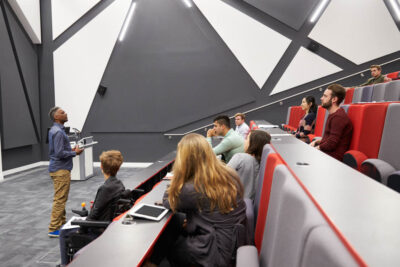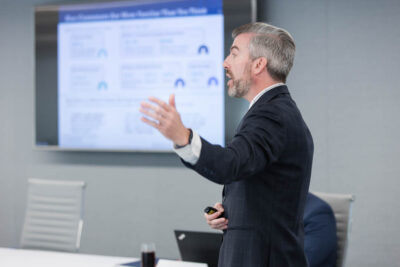Necessary infrastructure to support interdisciplinary programs
Kimber McKay
Interim Vice Provost for Academic Affairs, University of Montana
The views and opinions expressed are those of the author and do not necessarily represent the views or opinions of EAB.
Challenge and scene set
At our university, we are at an inflection point for how we envision and offer academic programs. I spent the last term considering this question: How can the University of Montana structure academic affairs to support and build upon our academic strengths and build interdisciplinary opportunities?
A challenge for launching interdisciplinary programs is that faculty and deans can fail to see how participation will help their bottom line. Faculty may also feel at capacity already, in teaching out the curriculum for existing majors, and feel they can’t add another obligation.
Clarity from leadership about how faculty participation in interdisciplinary programs will be rewarded is key; ROI considerations should be addressed concretely using data, market research, and support from IR and strategic leadership teams.
Assets
Many departments already house more than one degree program, and collaborate with other disciplines in their college. In fact, when speaking with faculty across our campus this term, it was common to hear people say: “Hang on, though…. we’re already interdisciplinary!” Many adjacent departments/degrees already work together. However, for cross-college interdisciplinary degrees, the degree of interdisciplinarity and the need for cooperation and support rises to the next level.
What interdisciplinary programs need are:
- Qualified faculty
- Customized cross-department/cross-college curricula
- A forum for decision-making about curriculum
-
Interested in the Rising Higher Education Leaders Fellowship?
Learn more about the program and future cohorts.
Finally, campuses need a designated leader to carry out or delegate decisions about interdisciplinary programming. A designated leader can provide institution-specific clarity regarding ownership and the allocation of funding to colleges and programs.
What are some incentives?
Many existing courses and programs already contain an interdisciplinary component. When in place, these are important opportunities to expand, model, and connect with new interdisciplinary efforts. Highlighting existing linkages and how they can be expanded can be important for incentivizing university leadership.
Structures may exist or need to be created for faculty to receive appropriate credit:
- Can result in faculty finding exciting new teaching opportunities and refreshed enthusiasm
- New grant opportunities emerge
- Student interest in programs increases
Other considerations are key, including developing an appropriate reporting structure within a university’s existing organizational framework. In brief, three reporting structures for interdisciplinary programs are
common:
- Programs that are inextricably linked to specific academic departments or colleges
- Colleges of ‘Interdisciplinary Studies’
- Programs that are administered centrally and roll up to the Office of the Provost
Solutions
A solution we are considering here at the University of Montana is to name an Associate Vice Provost for Interdisciplinary Studies. There may be some costs to locating this responsibility in an AVP—one is that the role would sit squarely in the administration, which many faculty see as separated from their work as educators/researchers. A sense that there is a gulf between admin and the faculty can prevail on campuses, and would need some attention in this model.
An AVP/Interdisciplinary has its upsides—AVPs often will have a dedicated budget, can have access to top leadership, and can be expected to be wholly devoted to building and supporting the interdisciplinary programs they oversee.
More Blogs

Fixing What’s Broken in Interdisciplinary Program Design

What higher ed can learn from these successful academic program revitalizations
